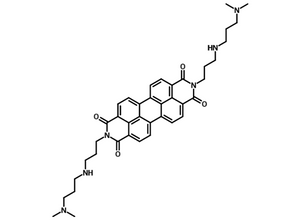PDINN, used to improve device stability in non-fullerene OSCs
High quality material available online (or request a quote) for priority dispatch
PDINN (CAS number 1020180-01-1), while compared with PDINO, can provide better contact with the electrodes and non-fullerene active layers to give higher conductivity. PDINN also can reduce the work functions (WFs) of the metal cathode, making it a better candidate to use as cathode interlayer materials (CIMs) in non-fullerene OSCs with air stable metal cathode, such as Ag and Cu, to improve the device stability.
With solubility of 26.7 mg/ml in methanol without any assistance from acetic acid, PDINN has better solubility than most of the CIMs such as PFN and PDIN which needs acetic acid to make a clear solution. PDINN also shows a better interfacial compatibility to a wider range of active layer materials to form better quality films for OSCs devices than PDINO.
Cathode interlayer molecule
For high efficient OPV applications
Perfect for non-fullerene solar cells
Compatible with high work function cathodes
Worldwide shipping
Quick and reliable shipping
Enhanced solubility
Compatible with wider range of active layer materials
With PDINN/Ag as the top electrode, the OSCs based on PM6:Y6 demonstrates a high PCE of 17.23%, the device has the following structure.
Device structure: ITO/PEDOT:PSS/PM6:Y6/PDINN (9 nm)/Ag [2]
| Thickness (nm) | VOC (V) | JSC (mA cm-2) | FF (%) | PCE (%) |
|---|---|---|---|---|
| N/A | 0.847 | 25.89 | 78.59 | 17.23 |
General Information
| CAS Number | 1020180-01-1 |
|---|---|
| Chemical Formula | C40H46N6O4 |
| Purity | >98% (1H NMR) |
| Full Name | N,N'-Bis{3-[3-(Dimethylamino)propylamino]propyl}perylene-3,4,9,10-tetracarboxylic diimide |
| Molecular Weight | 674.83 g/mol |
| HOMO / LUMO | HOMO = -6.02 eV LUMO = -3.78 eV [2] |
| Melting Point (DSC) | 240.1 °C (TGA, 5% weight loss) |
| Form | Deep red powder/crystals |
| Absorption | λmax 473 nm (film) |
| Solubility/Processing Solvents | Methanol, ethanol, trifluoroethanol |
| Synonyms |
BDMAPAP-PDI 2,9-Bis(3-((3-(dimethylamino)propyl)amino)propyl)anthra[2,1,9-def:6,5,10-d'e'f']diisoquinoline-1,3,8,10(2H,9H)-tetraone |
| Classification / Family | Perylene diimide (PDI), Cathode interlayer materials (CIMs), Organic semiconducting materials, Organic Photovoltaics, OLED, Small molecule electrolyte |
Chemical Structure

MSDS Documentation
Pricing
| Batch | Quantity | Price |
|---|---|---|
| M2234A1 | 250 mg | $416 |
| M2234A1 | 500 mg | $650 |
| M2234A1 | 1 g | $1,105 |
| M2234A1 | 5 g | $4,550 |
Literature and Reviews
- Cathode engineering with perylene-diimide interlayer enabling over 17% efficiency single-junction organic solar cells, J. Yao et al., Nat. Commun., 11, 2726 (2020); DOI: 10.1038/s41467-020-16509-w.
- Perylene diimides: a thickness-insensitive cathode interlayer for high performance polymer solar cells, Z. Zhang et al., Environ. Sci., 7, 1966 (2014); DOI: 10.1039/c4ee00022f.
- N,N'-bis[3,3'-(dimethylamino)propylamine]-3,4,9, 10-perylenetetracarboxylic Diimide, a Dicationic Perylene Dye for Rapid Precipitation and Quantitation of Trace Amounts of DNA, Z. Liu et al., Anal. Biochem, 5; 236(1):139-45 (1996); DOI: 10.1006/abio.1996.0142.


 PDINN MSDS Sheet
PDINN MSDS Sheet